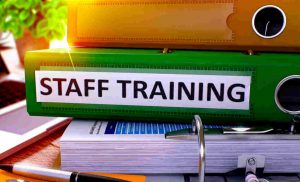Learning and development is key for any successful organisation. When employees continuously build their skills, they become more engaged, productive and add greater value to the company.
As a manager, being able to accurately identify individual learning needs is crucial for providing your team with growth opportunities. This allows you to create a development plan that aligns with their goals and strengths.
In this post, we’ll explore what learning needs are, why it’s important to identify them, and provide a short guide on how managers can pinpoint skills gaps and training requirements. Let’s get started!

What Are Learning Needs?
Learning needs, also called training needs, are the skills, knowledge, or competencies an employee is lacking that are required to successfully do their job. These needs can be identified by analysing performance gaps – the difference between an employee’s current capabilities and what’s required for them to fulfil their role effectively.
Learning needs fall into two main categories:
- Current role needs – Requirements to perform the employee’s existing job satisfactorily. These are needs they must meet now.
- Future growth needs – Skills staff will require to take on increased responsibilities or new positions in the future. These prepare them for career advancement.
Accurately spotting learning needs allows you to provide suitable development opportunities. This helps drive higher performance and prepares your team for future responsibilities.

Why Identify Learning Needs?
Pinpointing precisely where employees need to improve their skills or knowledge delivers multiple benefits:
Improves Individual Performance
Targeted training based on clear needs allows staff to sharpen skills that are holding them back. This directly translates to improved productivity and work quality.
Increases Employee Engagement
Employees feel valued when organisations invest in their growth. It shows you’re committed to their career progression and success. This boosts satisfaction and retention.
Prepares for Advancement
Helping staff build future-focused skills prepares them for promotions or career changes within the company. They’ll be ready to take on increased duties.
Maximises Training ROI
Understanding needs allows training to be tailored and relevant. This ensures development activities deliver a strong return on investment.
Strengthens Team Capabilities
Spotting collective knowledge or skill gaps across departments enables training to target areas that will benefit the wider team.
In summary, identifying needs provides focus to learning and development efforts for maximum impact. The key steps involved are assessing performance, evaluating capabilities, and pinpointing precise needs.
How to Identify Employee Learning Needs

The process of determining development requirements can be broken down into 6 key stages:
1. Gather Background Information
Start by collecting information about the employee’s performance and capabilities:
- Job description – Outlines key duties and skills needed for the role. Compare against the employee’s current expertise.
- Performance reviews – Details strengths, weaknesses and past development recommendations.
- 360-degree feedback – Seek input from managers, peers and direct reports on abilities.
- Work samples – Assess quality of current work products and outputs.
- Self-assessments – Get the employee’s input on their own skills and interests.
This provides context about competency gaps that may need development.
2. Identify Performance Shortfalls
Next, pinpoint any skills or knowledge deficiencies that are leading to poor performance:
- Where are they struggling to fulfil key responsibilities?
- What errors or mistakes are being made that affect quality or output?
- What are their notable strengths and weaknesses according to feedback?
- What development has been identified in past reviews?
Analysing performance metrics also reveals shortfalls. Compare samples of their work against expected standards. This highlights development areas linked directly to subpar results.
3. Evaluate Required vs Actual Skills
Compare the employee’s current skill set against the requirements of their role.
- What skills does the job description call for?
- Which capabilities are required to complete key activities well?
- Where are there gaps between their existing abilities and what’s needed?
Seeking input from the employee and manager will give greater insights on any misalignments between actual vs required competencies.
4. Identify Cause of Gaps
Before defining solutions, it’s important to dig into the root of performance gaps:
- Are they lacking core skills required for the role? Is additional training needed?
- Are they lacking motivation and engagement at work? Are there ways to provide more stimulation?
- Are weaknesses due to poor work processes or tools? Can these be improved?
- Are health or personal issues impacting work? Is support required here?
Understanding why gaps exist ensures training addresses the real problem, rather than just symptoms.
5. Agree on Development Needs
Finally, document specific learning needs and have the employee agree that training in these areas will aid their performance and growth.
Be as detailed, concrete and objective as possible. Tie needs directly to the employee’s goals, job duties and observed skill gaps. Some examples:
- Improve presentation skills to deliver more impactful pitches and presentations.
- Build knowledge of new accounting software to utilise system features and reduce errors.
- Develop coaching skills to provide better support and development to direct reports.
Now you have a solid basis for creating a targeted development plan! Continue collaborating with the employee so training remains relevant as needs evolve.
6. Get manager opinions
Managers know what their employees are capable of, and where they may be falling short. Apart from this, they can even reveal what their employees are gaining from the training program and what is not covered that employees may find beneficial.
For instance, if a manager reveals an employee is interested in learning new skills but are unable to learn much from the training program because of its complicated platform, L&D pros can opt for a more flexible platform like Litmos which is easy to use.
Creating a Development Plan
Once you’ve identified precise learning needs, the next step is translating these into a tangible development plan.
Here are some tips for creating an effective plan:
- List development activities – Specify training programmes, courses, shadowing, mentoring and other activities that will close skill gaps.
- Assign completion timelines – Set deadlines for completing each activity that align with performance targets.
- Define success metrics – Determine measurable outcomes so you can evaluate progress, like improved sales results or fewer errors.
- Outline required resources – Detail any budgets, tools, or other support needed to facilitate the training.
- Schedule reviews – Set dates to meet with the employee and evaluate how activities are meeting needs.
- Incorporate feedback – Solicit the employee’s input to ensure they feel the plan fits their needs and interests.
- Update as needs change – Review progress regularly and adjust activities as capabilities improve and new gaps emerge.
Approaching development as an ongoing process, rather than a one-off event, will give you the best results.
FAQs
How often should learning needs be identified?
Formally assess needs at least once a year, such as in annual performance reviews. Also evaluate them on an ongoing basis by checking in with employees frequently and monitoring work. This allows you to spot new gaps as they emerge.
What tools can identify learning needs?
Surveys, skills assessments, 360-degree feedback, performance reviews and competency models are all useful tools. Job descriptions, work samples and metrics can provide objective measures of gaps too.
Should managers or employees raise learning needs?
Both perspectives are important. Managers may spot needs employees are unaware of through work observation. But staff should also self-identify areas they wish to develop. Discuss together to gain alignment.
How can learning needs be effectively communicated?
Focus on clear, specific skills or knowledge the training will build, rather than vague development areas. Use measurable language and tie needs directly to job requirements and objectives.
How to prioritise learning needs?
Prioritise urgent needs impacting current performance first. Then focus on developing skills for near-term career growth. Nice-to-have development can follow these priorities. Align with company goals.
What happens after identifying learning needs?
Identified needs should be documented in an employee development plan outlining specific training activities, resources required, success metrics and review dates. Needs should be re-evaluated after training.
How can managers support learning needs?
Managers play an important role in reinforcing training through setting goals, providing on-the-job guidance and giving opportunities to apply new skills. Follow up frequently to ensure needs are being met.
What if an employee resists identified needs?
Discuss reasons for resistance respectfully. Emphasise how training will benefit their performance and growth. Involve them in creating the development plan so it addresses their concerns.
How to develop learning needs remotely?
Virtual training, e-learning, webinars, video coaching and online courses can all help remote employees develop needs. Schedule regular check-ins and provide opportunities to practice skills.
In Summary
Identifying specific learning needs provides the foundation for employee growth and improved performance. By regularly assessing development gaps at both individual and team levels, you can create targeted training plans that deliver meaningful results. Begin by gathering performance information, pinpointing shortfalls, evaluating required skills and delving into the root causes of needs. Then, collaborate with staff to create a development roadmap. Keep fine-tuning this as needs evolve to support ongoing learning.
Disclosure: The articles, guides and reviews on BlowSEO covering topics like SEO, digital marketing, technology, business, finance, streaming sites, travel and more are created by experienced professionals, marketers, developers and finance experts. Our goal is to provide helpful, in-depth, and well-researched content to our readers. You can learn more about our writers and the process we follow to create quality content by visiting our About Us and Content Creation Methodology pages.

